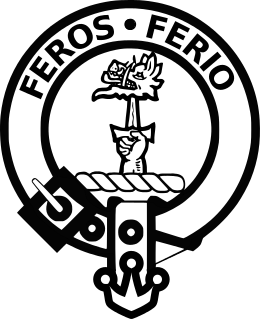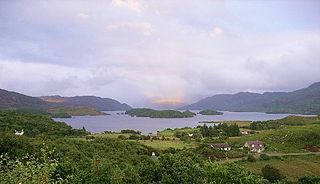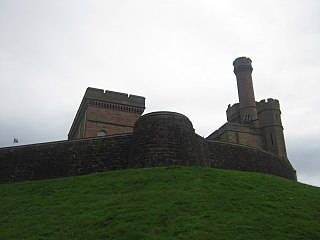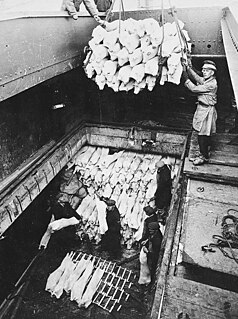
Clan Ross is a Highland Scottish clan. The original chiefs of the clan were the original Earls of Ross.

Earl of Cromartie is a title that has been created twice, both for members of the Mackenzie family. It was first created as Earl of Cromarty in the Peerage of Scotland in 1703 for Sir George Mackenzie, 2nd Baronet, but his titles were forfeited after the Jacobite rising of 1745. It was recreated in 1861 in the Peerage of the United Kingdom for Anne Sutherland-Leveson-Gower, Duchess of Sutherland. Since 1979, the Earl of Cromartie has been chief of Clan Mackenzie.

Clan Mackenzie is a Scottish clan, traditionally associated with Kintail and lands in Ross-shire in the Scottish Highlands. Traditional genealogies trace the ancestors of the Mackenzie chiefs to the 12th-century. However, the earliest Mackenzie chief recorded by contemporary evidence is Alexander Mackenzie of Kintail who died some time after 1471. Traditionally, during the Wars of Scottish Independence, the Mackenzies supported Robert the Bruce, but feuded with the Earls of Ross in the latter part of the 14th-century. During the 15th and 16th-centuries the Mackenzies feuded with the neighboring clans of Munro and MacDonald. In the 17th-century the Mackenzie chief was made Earl of Seaforth in the peerage of Scotland. During the Scottish Civil War of the 17th-century the Mackenzies largely supported the Royalists. During the Jacobite rising of 1715 the chief and clan of Mackenzie supported the Jacobite cause. However, during the Jacobite rising of 1745 the clan was divided with the chief, Kenneth Mackenzie, Lord Fortrose, supporting the British-Hanoverian Government and his relative, George Mackenzie, 3rd Earl of Cromartie, supporting the Jacobites.

The Clan Macrae is a Highland Scottish clan. The clan has no chief; it is therefore considered an armigerous clan.

Clan Rose is a Highland Scottish clan.

Clan Chisholm is a Highland Scottish clan.

Clan MacLennan, also known as Siol Ghillinnein, is a Highland Scottish clan which historically populated lands in the north-west of Scotland. The surname MacLennan in Scottish Gaelic is Mac Gille Fhinnein, meaning the son of the follower of St Finnan.

The Battle of Bealach nam Broig was a battle fought between Scottish clans from the lands of north-west Ross, against north-eastern clans of Ross who supported the Earl of Ross. The actual date of the battle is debated, it probably occurred in 1452 but the Conflicts of the Clans suggests a date as early as 1299.

Clan MacIver or Clan MacIvor, also known as Clan Iver, is Scottish clan recognised by the Lord Lyon King of Arms. The clan, however, does not have a chief recognised by the Lord Lyon King of Arms. Because of this the clan can be considered an armigerous clan. The clan name of MacIver is of Gaelic origin, derived from an Old Norse personal name. Various forms of the surname MacIver, like MacGiver, are considered sept names of several historically large Scottish clans, such as clans Campbell and Mackenzie. There exists a Clan Iver society in Fife, Scotland.
Manrent refers to a Scottish contract of the mid-15th century to the early 17th century, usually military in nature and involving Scottish clans. The bond of manrent was commonly an instrument in which a weaker man or clan pledged to serve, in return for protection, a stronger lord or clan—in effect becoming a vassal that renders service to a superior, often made in the form of a covenant. Manrents were a Promise by one person to serve another, [such] that he shall be friend to all his friends, and foe to all his foes.

The Battle of Blar na Pairce was a Scottish clan battle that took place just outside Strathpeffer some time between 1485 and 1491. It was fought between men of the Clan Donald or MacDonald and the Clan Mackenzie.

The Battle of Morar was a Scottish clan battle fought in 1602, near Loch Morar, in the Scottish Highlands. It was fought between the Clan MacDonell of Glengarry against the Clan Mackenzie who were supported by the Clan Ross.

Clan Munro is a Highland Scottish clan. Historically the clan was based in Easter Ross in the Scottish Highlands. Traditional origins of the clan give its founder as Donald Munro who came from the north of Ireland and settled in Scotland in the eleventh century, though its true founder may have lived much later. It is also a strong tradition that the Munro chiefs supported Robert the Bruce during the Wars of Scottish Independence. The first proven clan chief on record however is Robert de Munro who died in 1369; his father is mentioned but not named in a number of charters. The clan chiefs originally held land principally at Findon on the Black Isle but exchanged it in 1350 for Estirfowlys. Robert's son Hugh who died in 1425 was the first of the family to be styled "of Foulis", despite which clan genealogies describe him as 9th baron.

The Siege of Inverness that took place in November 1715 was part of the Jacobite rising of 1715. The town of Inverness and Inverness Castle were being held by the Clan Mackenzie, led by Sir John Mackenzie of Coul who supported the rebel Jacobite cause. Simon Fraser, 11th Lord Lovat, chief of the Clan Fraser of Lovat besieged them, supported by men of the Clan Rose and Clan Forbes.

The Battle of Glen Affric took place in 1721 in Glen Affric, in the Scottish Highlands. It was fought between Government backed forces of the Clan Ross against rebel the forces of the Clan Mackenzie and their allies the Clan Macrae.

The Skirmish of Alness was a conflict that took place in October 1715 in Alness, in the county of Ross in the Scottish Highlands. It was part of the Jacobite rising of 1715 and pitted Highlanders loyal to the British-Hanoverian Government of George I of Great Britain against Highlanders loyal to the Jacobite House of Stuart.

The Siege of Brahan took place in Scotland in November 1715 and was part of the Jacobite rising of 1715. Highlanders loyal to the British-Hanoverian government of George I of Great Britain laid siege to Brahan Castle, seat of William Mackenzie, 5th Earl of Seaforth, who was a staunch Jacobite, loyal to the House of Stuart.

The Battle of Drumchatt, or Druim-a-Chait was a Scottish clan battle claimed by non-contemporary historians to have taken place in the year 1501 near Strathpeffer, in the Scottish Highlands. It was allegedly fought between the Clan Mackenzie and the Clan Munro. Mackenzie chronicles have claimed a signal victory.

The Battle of the Braes of Strathdearn was a Scottish clan battle that took place in 1645 in Strathdearn, Scottish Highlands. It was fought by the Clan Grant who defeated the Clan Cameron, after the Camerons had raided the Grant's lands.


















